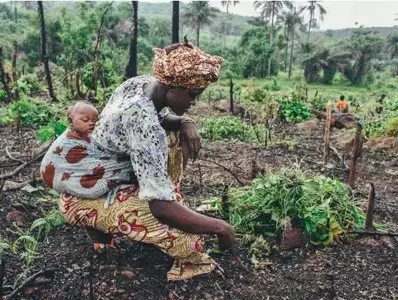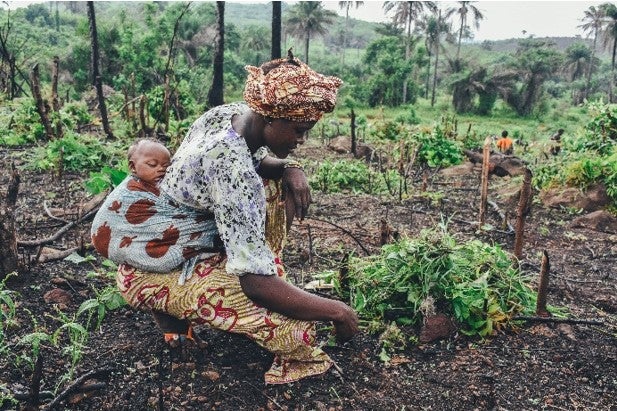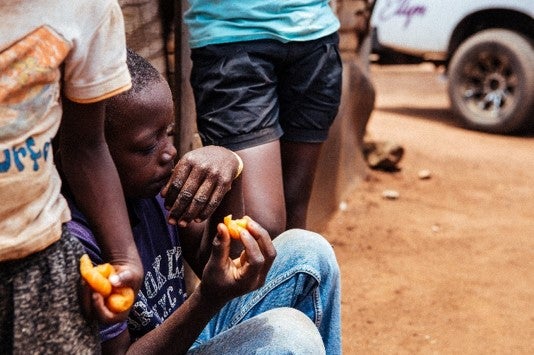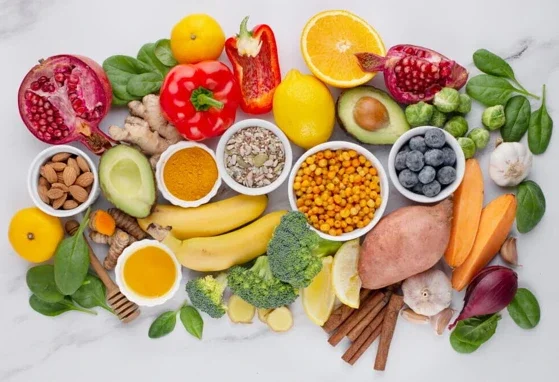Are community gardens, urban and home farms the key to improved nutrition?


The theme for this year’s Nutrition Week (held from 9-15 October) is to “eat more vegetables and fruit every day”, for their health and nutritional benefits.
It is a fact that a diet rich in a variety of fruit and vegetables is essential for the prevention and management of conditions such as high blood pressure, cholesterol, heart disease, diabetes and cancer. To this end the WHO and the FAO recommend that individuals eat a minimum of five portions of diverse, fresh fruit and vegetables (at least 400 grams) each day, for optimum health.1
In low- and middle-income countries, only a small portion of the adult population – as little as 18%, according to one study – eats this recommended quantity. 2 In South Africa, the average plate consists of 41% starch, mostly bread, and 26% meat, mostly chicken. Only 13% of the plate is vegetables (and this is often limited to one or two veggies).3 The cause may be any of several hindering factors (educational, social and economic). Educational programmes have shown positive outcomes in upper-income countries but these programmes have limited success in middle- and lower-income countries.2
It has been established that “people’s consumption of vegetables and fruit is directly related to their socio-economic situations and food environments”.4& 5 In low- and middle-income countries, the availability and affordability of food is a major concern. The rise in urbanisation and urban sprawl in these countries, is another factor, driving up food prices and food waste.6
 In South Africa, for example, 51% of children are reported to be malnourished, as a result of the low affordability of healthy food. In fact, foods with a low nutritional value are sometimes more affordable than fruit and vegetables.7 & 8
In South Africa, for example, 51% of children are reported to be malnourished, as a result of the low affordability of healthy food. In fact, foods with a low nutritional value are sometimes more affordable than fruit and vegetables.7 & 8
In certain communities, limited access to vegetables and fruit is an issue (compounded by poverty). Individuals in rural South African communities have limited financial means, allowing them to buy sufficient maize for daily meals, but little else. Diets are therefore rich in starches but lacking in other nutrients. During winter, when local maize crops are in short supply, the problem worsens. As a result, micronutrient deficiencies are common, coupled with the increasing rate of over-weight South African populations.9 Anecdotal evidence for Africa suggests that the seasonal availability of fruit and vegetables also limits their consumption.10
Another challenge is food loss or food waste. “Globally, 40–50% of root crops, fruits, and vegetables are wasted each year, perishing during harvest, storage, transport, packaging, and distribution” 2. This challenge is acute in poorer countries (and more so in countries with hot climates), where distribution systems are inadequate and food waste is exacerbated. In African countries, it is believed that post-harvest losses of food cereals amount to 25% of the total crop harvested. For crops such as fruit and vegetables, the losses can reach 50%.11
Community gardens, urban farms and home farming have been identified as possible solutions, for a number of reasons, including:12 & 13
- Affordability: Growing vegetables and fruit at home (or in an urban garden) can provide more affordable healthy food, than what is available in stores.
- Reduced food waste (and improved availability of perishable food), as food is consumed where it is farmed (or close by).
- Improved food and nutritional security, as there is a consistent, accessible and reliable supply of nutritious food.
- Improved diet diversity and food preference, as it is possible to grow a wider variety of nutritious foods than might otherwise be available.
- Additional income opportunity: Surplus food can be sold or traded, generating an additional income for the household or community.
It has been noted that a renewed focus on indigenous and traditional foods crops (ITFCs) will be beneficial. These crops may be negatively perceived, but are nutrient-dense, resilient and biodiverse.14
More than 35% of the fatalities worldwide are the result of nutritional deficits.15 Improving nutrition, namely by increasing the daily consumption of healthy fruit and vegetables, is key. Yet to achieve this, there “is a need for multiple public and private sectors to work together to increase the availability of affordable vegetables and fruit in our communities, schools and workplaces”.
3 extra tips for more affordable healthy eating
- Eat with the seasons
Foods that are in-season are usually cheaper (more affordable). These can be purchased in larger quantities, chopped and stored in the freezer, for example.1
- Buy or grow foods with a longer shelf-life
Some fruit and vegetables stay fresher for longer than others (meaning they’re a good option for bulk purchases).1 These include pumpkins, beetroots, carrots and cabbage.16
- Embrace ‘zero-waste’ cooking
Zero-waste cooking is about using the whole fruit/vegetable, so no part of it is thrown away. For example, using the peel, stems and leaves of vegetables in foods, to add flavour or texture, or to add flavour to say, jams or juices.17 The non-edible components (such as egg shells or banana peels) may have other uses. For example, they can be dried out and used as a scrub for cleaning pots and pans. And, of course, most food “waste” can be composted or used as fertiliser.
The increased daily consumption of fruit and vegetables is a priority for health, yet for African communities, there are unique challenges that impede the sustained adoption of healthier diets.
- Nutritionweek.co.za. n.d. National Nutrition Week 2021 - FAQs. online Available at: <https://www.nutritionweek.co.za/NNW2021/faqs> Accessed 11 October 2021.
- Siegel, K., 2019. Insufficient Consumption of Fruits and Vegetables among Individuals 15 Years and Older in 28 Low- and Middle-Income Countries: What Can Be Done?. The Journal of Nutrition, online 149(7), pp.1105-1106. Available at: <https://academic.oup.com/jn/article/149/7/1105/5510607> Accessed 11 October 2021.
- de Wet, P., 2020. We just learnt what South Africans eat: 67% meat and starch – with only sporadic vegetables. online Businessinsider.co.za. Available at: <https://www.businessinsider.co.za/typical-south-african-plates-are-starch-and-meat-heavy-everywhere-and-for-everyone-2020-3> Accessed 12 October 2021.
- Nutritionweek.co.za. n.d. National Nutrition Week 2021 - Introduction. online Available at: <https://www.nutritionweek.co.za/NNW2021/introduction> Accessed 11 October 2021.
- Okop, K., Ndayi, K., Tsolekile, L., Sanders, D. and Puoane, T., 2019. Low intake of commonly available fruits and vegetables in socio-economically disadvantaged communities of South Africa: influence of affordability and sugary drinks intake. BMC Public Health, online 19(1). Available at: <https://bmcpublichealth.biomedcentral.com/articles/10.1186/s12889-019-7254-7#citeas> Accessed 11 October 2021.
- 2021. online Available at: <https://www.farmersweekly.co.za/opinion/by-invitation/how-urban-agriculture-can-contribute-to-food-security/> Accessed 11 October 2021.
- Del Monte, C., 2021. Why nutritional intake for South Africa’s children is far from ideal and what to do about it. online The Daily Maverick. Available at: <https://www.dailymaverick.co.za/article/2021-09-06-why-nutritional-intake-for-south-africas-children-is-far-from-ideal-and-what-to-do-about-it/> Accessed 11 October 2021.
- Faber, M., Laubscher, R. and Laurie, S., 2011. Availability of, access to and consumption of fruits and vegetables in a peri-urban area in KwaZulu-Natal, South Africa. Maternal & Child Nutrition, 9(3), pp.409-424.
- Hendriks, S. and McIntyre, A., 2016. Why a diverse diet is crucial for rural South Africans. online The Conversation. Available at: <https://theconversation.com/why-a-diverse-diet-is-crucial-for-rural-south-africans-57304> Accessed 11 October 2021.
- Ruel, M., Minot, N. and Smith, L., 2005. Patterns and determinants of fruit and vegetable consumption in sub-Saharan Africa: a multicountry comparison. ebook World Health Organisation. Available at: <https://www.who.int/dietphysicalactivity/publications/f%26v_africa_economics.pdf> Accessed 12 October 2021.
- UN Environment Programme. n.d. Worldwide food waste. online Available at: <https://www.unep.org/thinkeatsave/get-informed/worldwide-food-waste> Accessed 12 October 2021.
- Suri, S., 2020. Nutrition Gardens: A Sustainable Model for Food Security and Diversity. ebook ORF Issue Brief. Available at: <https://www.orfonline.org/wp-content/uploads/2020/06/ORF_Issue_Brief_369_Nutrition_Gardens.pdf> Accessed 11 October 2021.
- Beach, M., 2013. Urban Agriculture Increases Food Security for Poor People in Africa. online PRB. Available at: <https://www.prb.org/resources/urban-agriculture-increases-food-security-for-poor-people-in-africa/> Accessed 11 October 2021.
- Akinola, R., Pereira, L., Mabhaudhi, T., de Bruin, F. and Rusch, L., 2020. A Review of Indigenous Food Crops in Africa and the Implications for more Sustainable and Healthy Food Systems. Sustainability, online 12(8), p.3493. Available at: <https://www.ncbi.nlm.nih.gov/pmc/articles/PMC7116648/> Accessed 11 October 2021.
- Galhena, D., Freed, R. and Maredia, K., 2013. Home gardens: a promising approach to enhance household food security and wellbeing. Agriculture & Food Security, online 2(1). Available at: <https://agricultureandfoodsecurity.biomedcentral.com/articles/10.1186/2048-7010-2-8>.
- Smith, D., 2016. 7 Vegetables That Stay Fresh for Months. online Time. Available at: <https://time.com/4217330/vegetable-guide/> Accessed 12 October 2021.
- Sacks, K., 2020. Zero Waste Cooking: 17 Ways to Reduce Food Waste in the Kitchen. online FoodPrint. Available at: <https://foodprint.org/blog/zero-waste-cooking/> Accessed 11 October 2021.
If you liked this post you may also like




